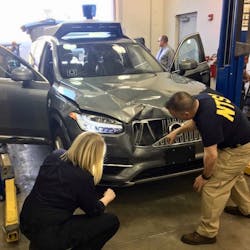NTSB determines probable cause of Uber automated test vehicle crash in Arizona
The National Transportation Safety Board (NTSB) recently held a board meeting to determine the probable cause of the March 2018 fatal collision between an Uber automated test vehicle and a pedestrian in Tempe, Arizona.
During the meeting, the NTSB said that Uber Technologies Inc. division's "inadequate safety culture" contributed to the nighttime fatal collision. The vehicle operator was uninjured in the crash, while the pedestrian was killed.
According to NTSB, Uber’s Advanced Technologies Group (ATG) had modified the striking vehicle, a 2017 Volvo XC90, with a proprietary developmental automated driving system. The vehicle’s factory-installed forward collision warning and automatic emergency braking systems were deactivated during the operation of the automated system. An Uber ATG operator was in the driver’s seat, but the automated system was controlling the vehicle when it struck the pedestrian at 39 mph.
The NTSB determined that the immediate cause of the collision was the failure of the Uber ATG operator to closely monitor the road and the operation of the automated driving system because the operator was visually distracted throughout the trip by a personal cell phone. Contributing to the crash was Uber ATG’s inadequate safety risk assessment procedures, ineffective oversight of the vehicle operators, and a lack of adequate mechanisms for addressing operators’ automation complacency.
The pedestrian’s impairment at the time of the crash, coupled with crossing outside a crosswalk, contributed to the crash, as did the Arizona DOT’s insufficient oversight of automated vehicle testing, the NTSB found.
One of the findings in the investigation included that the automated driving system detected the pedestrian 5.6 seconds before impact.; although the system continued to track the pedestrian until the crash, it never accurately identified the object crossing the road as a pedestrian or predicted its path. The agency also said that had the vehicle operator been attentive, the operator would likely have had enough time to detect and react to the crossing pedestrian to avoid the crash or mitigate the impact.
The NTSB recommended that the National Highway Traffic Safety Administration (NHTSA) require the submission of safety self-assessment plans by entities wishing to test a developmental automated driving system on public roads before being allowed to begin or continue testing.
A full report of the NTSB's findings is expected to be released within the next few weeks.
-------
SOURCE: NTSB
